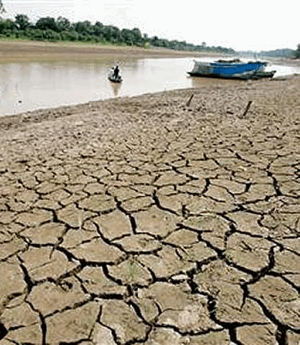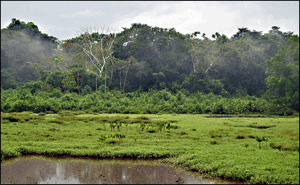Amazon Forest as a Source of Carbon Dioxide
Air Date: Week of February 11, 2011

Red regions on this map of the Amazon show areas of below average rainfall in 2005. (Photo: NASA)
In 2005, the Amazon experienced a once-in-a-century drought. Just five years later, the drought was even worse. University of Leeds Professor Oliver Phillips tells host Bruce Gellerman that such extreme droughts cause the Amazon to be a source of carbon dioxide instead of a carbon sink.
Transcript
GELLERMAN: Well, while Congress debates the laws of man, climate scientists continue to investigate the laws of nature. In the Amazon forest researchers are trying to calculate the damage from 2 severe droughts.
In recent years there's been a distinct lack of rain in the Amazon rainforest. “The drought of the century” is what they called the first in 2005, but the second, just 5 years later, was even worse. The forest is drying and the trees are dying, destroying the vast region’s ability to absorb carbon from the atmosphere. University of Leeds researcher Oliver Phillips says instead of acting as a carbon sink, the Amazon forest is becoming a huge source of climate changing gases.

In 5 years the Amazon has experienced 2 extremely severe droughts. (Earth Week)
PHILLIPS: In 2005, we think the Amazon lost about 1 billion tons of carbon. What droughts do is they - theyÂ’ve killed trees. As all that dead wood decays, that gets converted into carbon dioxide, and thatÂ’s what then goes to the atmosphere. So, what happened - the 2005 drought, what it did was actuallyÂ…it stopped the sink, it flipped it the other way to a source, and it increased the magnitude by two. So it went from a moderate sink to a strong source as a result of 2005.
GELLERMAN: Whoa!
PHILLIPS: Yeah, so it was a big impact. A billion metric tons is close to the emissions of all the cars on earth at the moment. In other words, the amount of CO2 that theyÂ’re emitting was actually a little bit less than the impact of the 2005 drought. So, the question now after the 2010 drought, which was bigger in climatological terms than 2005, is: did that also kill trees? And we suspect, based on our 2005 analysis, that 2010 will have killed even more trees and have caused even more carbon to be emitted to the atmosphere.

Red regions on this map of the Amazon show areas of below average rainfall in 2005. (Photo: NASA)
GELLERMAN: Really what we are looking at here is kind of a giant feedback loop - the more drought we have, the more trees die, which will lead to more droughtÂ…
PHILLIPS: Well, there are lots of possible interactions in the system. Now, one of them is the system gets drier then growth may decline and the death of trees may accelerate, so you get release of carbon to the air, and that in turn, etc., is climate change. And we expect that the changing climate this century will act to strengthen the dry season, particularly across the southern Amazon. So the kind of droughts we are seeing now - they are consistent with the global climate change picture.
GELLERMAN: Do these intense droughts - do they affect the composition of the forest? The types of trees that survive?
PHILLIPS: Last time, in 2005, we did find that the drought was actually killing some kinds of trees more than others. On some of the plots it was the palms, which were really suffering. And that kind of makes sense in ecological terms, because these are species which are found mostly in the western, wet part of the Amazon, and tend to drop out in the drier areas.
So the implication is: if we have several of these droughts, one after the other, that would drive some change in the composition - or if you like, the biodiversity - of the system. And of course, naturally, we would expect that those kinds of trees which are more resilient to drought may turn out to be the winners if this process continues.
GELLERMAN: But those trees which you call winners - are they good at absorbing carbon - lots of carbon? Or are the losers the ones that absorb carbon?

Research shows that the Amazon rainy season is much the same but the dry season is lasting longer. (Photo: NASA)
PHILLIPS: On average the trees in the drier part of the Amazon are a little bit shorter than in the wetter part. So we expect if the forest dries, that the average height of the tree will start to decline. It will change in form in the kinds of species, and some carbon will be lost.
GELLERMAN: The last sentence of your study in Science really sent shivers up my spine, and I’m going to quote, it says, “If drought events continue, the era of intact Amazon forest buffering the increase in atmospheric carbon dioxide may have passed.” In other words, if we have more droughts, then the Amazon’s ability to absorb more carbon dioxide is over.
PHILLIPS: Yeah, yup. ThatÂ’s possible. I mean, when you think about the implications of that, itÂ’s really - the earth is a big place, obviously, and itÂ’s not just the Amazon which is important in affecting the rate in which CO2 is increasing in the atmosphere. There are other big carbon sinks tooÂ…thereÂ’s African forest, which is also large, and there are forests in the temperate zone, in the US and in Europe - there are big forest areas which are probably currently absorbing carbon.
And if you add up all of those forest areas around the world, they provide us with a hell of a service so far in slowing down the rate at which CO2 is accumulating in the atmosphere. The scenario for this century now is whatÂ’s going to happen to those carbon sinks. If those sinks slow down and stop, then we can emit that much less carbon dioxide if we want to keep our earth a safe place to live.
GELLERMAN: Oliver Phillips is a professor of Geography at the University of Leeds in the UK, and co-author of the study, “The 2010 Amazon Drought” in Science Magazine.
Links
Click Here to Read the Abstract of the Report 2010 Amazon Drought
Living on Earth wants to hear from you!
Living on Earth
62 Calef Highway, Suite 212
Lee, NH 03861
Telephone: 617-287-4121
E-mail: comments@loe.org
Newsletter [Click here]
Donate to Living on Earth!
Living on Earth is an independent media program and relies entirely on contributions from listeners and institutions supporting public service. Please donate now to preserve an independent environmental voice.
NewsletterLiving on Earth offers a weekly delivery of the show's rundown to your mailbox. Sign up for our newsletter today!
 Sailors For The Sea: Be the change you want to sea.
Sailors For The Sea: Be the change you want to sea.
 The Grantham Foundation for the Protection of the Environment: Committed to protecting and improving the health of the global environment.
The Grantham Foundation for the Protection of the Environment: Committed to protecting and improving the health of the global environment.
 Contribute to Living on Earth and receive, as our gift to you, an archival print of one of Mark Seth Lender's extraordinary wildlife photographs. Follow the link to see Mark's current collection of photographs.
Contribute to Living on Earth and receive, as our gift to you, an archival print of one of Mark Seth Lender's extraordinary wildlife photographs. Follow the link to see Mark's current collection of photographs.
 Buy a signed copy of Mark Seth Lender's book Smeagull the Seagull & support Living on Earth
Buy a signed copy of Mark Seth Lender's book Smeagull the Seagull & support Living on Earth

